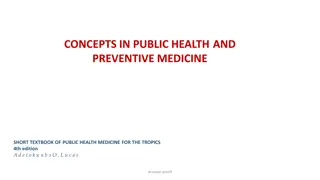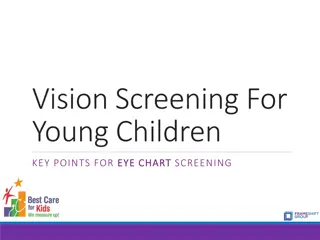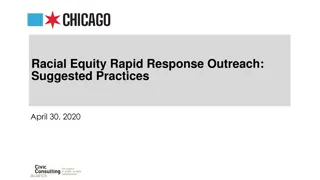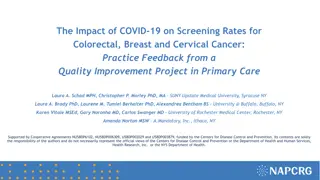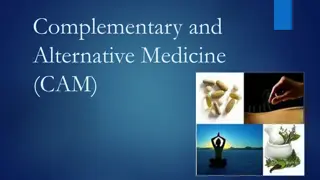Understanding Disease Screening and Prevention in Medicine
Explore the concepts of disease screening and prevention in preventive medicine. Learn about the importance of recognizing preclinical cases, the iceberg phenomenon of disease, and the role of medical intervention in arresting disease progression. Discover when to apply screening, the types of screening, and the criteria for screening tests.
Download Presentation

Please find below an Image/Link to download the presentation.
The content on the website is provided AS IS for your information and personal use only. It may not be sold, licensed, or shared on other websites without obtaining consent from the author. Download presentation by click this link. If you encounter any issues during the download, it is possible that the publisher has removed the file from their server.
E N D
Presentation Transcript
Screening Prof Jasim N. Al-Asadi 2018 - 2019
Learning objectives At the end of this lecture the student should be able to: Define screening Understand the types of screening When to apply screening List the uses and abuses of screening Describe the criteria of screening test
Assumptions In the field of preventive medicine, three assumptions are made: 1. Health and disease process does not follow all or none phenomenon. There is a progress of health status from a state of optimal health to a state of disease which ends in cure, chronicity, disability or death. This is called Natural history of the disease .
2. Doctors do not see or recognize all the ill people. There is an iceberg of unrecognized or unreported preclinical and clinical cases of the disease. What they see is only the tip of the iceberg.
The submerge portion of the iceberg represents the hidden mass of the disease (e.g. subclinical cases, carriers, undiagnosed cases). The floating tip represents what the physician sees in his practice. iceberg Iceberg Phenomenon of Disease
3. Medical intervention helps in arresting or reversing the disease process. This is more likely if: The intervention is achieved early. The natural history of disease is modifiable by the intervention in favor of better outcome. There is an effective intervention in the disease process.
Screening Spectrum Pre-symptomatic disease Recognized symptomatic disease Risk factor Unrecognized symptomatic disease Decreasing numbers labeled and treated Decreasing benefit
Different kinds of testing in medicine Diagnostic: specifically looking for a suspected condition which is tested for and confirmed or excluded Case-finding: usually in an investigation of exposed people, to sort the exposed and ill from the exposed and well. (e.g. test people who were in contact with a case of tuberculosis, or check B.P. of patient who is overweight) Opportunistic case-finding: A test is offered to an individual without symptoms of the disease when they present to a health care practitioner for reasons unrelated to that disease. Screening: usually no specific exposure or indication that the individual has disease. (e.g. routine mammography testing in middle-aged females)
What is screening? Screening is the testing of apparently healthy people to identify previously undiagnosed disease or people at high risk of developing a disease. Screening is used to detect early disease before it becomes symptomatic. Screening is an important aspect of secondary prevention, but not all diseases are suitable for screening.
Two essential attributes of successful secondary prevention Screening must achieve early detection of disease. The screening program must detect disease in asymptomatic persons or in symptomatic persons not recognized to have disease. Relative to background conditions, screening must identify affected persons at an earlier time point in the natural history of disease. 1. The act of early detection increases the effectiveness of treatment of the disease. 2.
Definition of Screening ? Screening is the presumptive identification of unrecognized disease or defects by the application of tests, examinations, or other procedures that can be applied rapidly. Positive screening results are followed by diagnostic tests to confirm actual disease.
Aim The basic purpose of screening is to sort out from a large group of apparently healthy persons those who are likely to have the disease or at increased risk of the disease under study, and to bring those who are "abnormal" under medical supervision and treatment.
Uses of screening a) Case detection - The presumptive identification of unrecognized disease, which does not arise from a patient's request. To make sure that appropriate treatment is started early. b) Control of disease - People are examined for the benefit of others, e.g., screening of immigrants from infectious disease such as tuberculosis and syphilis to protect the home population.
Uses of screening c) Research purposes - e.g. cancer, hypertension. Screening may aid in obtaining more basic knowledge about the natural history of such diseases. d) Educational opportunities - screening programs (as for example, screening for diabetes) provide opportunities for creating public awareness and for educating health professionals.
Abuses of screening Inappropriate application or interpretation of screening tests can: 1. Deprive people of their perceived health 2. Initiate harmful diagnostic testing 3. Waste health-care resources.
Types of screening Mass screening: Screening of the whole population or a subgroup. e.g. Screening for visual defects in school children, and Mammography in women aged > 40 years. High risk or selective screening: screening of risk population only. e.g. obese people for early detection of diabetes.
Multiphasic (multiple) screening: Application of two or more screening tests to a large population at one time. e.g. screening of pregnant women for syphilis, AIDS, Viral B hepatitis by serological tests. Case-finding or opportunistic screening: It is a form of screening restricted to patients who consult a health practitioner for some other purpose.
Screening Biases Common biases in screening include: 1. Lead time bias 2. Length time bias 3. Referral/Volunteer bias 4. Over diagnosis & detection bias (the detection of insignificant disease)
Lead time It is the length of time between the detection of disease (usually based on new, experimental criteria) and its usual clinical presentation and diagnosis (based on traditional criteria). Or It is the time between early diagnosis with screening and the time in which diagnosis would have been made without screening. It is an important factor when evaluating the effectiveness of a specific test
Lead Time Bias Screening identifies disease during a latent period before it becomes symptomatic It gives false impression of improved survival in a screened population without affecting mortality If survival is measured from time of diagnosis, screening will always improve survival even if treatment is ineffective
Length time Bias which stems from the fact that the same disease may progress at different rates in different individuals. Length time is the amount of time it takes for a disease to progress to a particular end point (e.g., symptom manifestation or death). D= Died S= Screened
Referral/Volunteer bias (selection bias) It is the systematic error that results from detecting disease in persons who have a propensity to seek health care. Breast Cancer Screening - HIP Experience Data from the Health Insurance Program (HIP) in New York are represented as rates of death in 10,000 women per year, from all causes and from cardiovascular (CV) disease causes in the table below:
The control group has death rates of 54 and 25/10,000. The experimental group, women who were screened, were recruited by two different ways: 1) Women who volunteered, after being asked to participate 2) Women who did not volunteer to be screened, after being asked to participate The women who volunteered for screening had much lower rates of death, both all causes and cardiovascular causes. The women who volunteer appear tend to have higher SES and adhere better to therapy. The women who were offered to participate in the program, but refused, have the highest death rates. If a screening study does not include a randomized process for selection, volunteers for the study are likely to be in better health than the general population.
How to Avoid Bias For lead time bias use mortality rather than survival rates, and count from date of randomization A randomized clinical trial design can reduce biases: For length time bias count all outcomes regardless of method of detection For volunteer bias count all outcomes regardless of group; follow-up those who refuse to get outcomes
Other Bias of screening Overdiagnosis bias: A screening program has a tendency to discover cancer that will not affect the life expectancy of the patient, or an insignificant disease. For example, autopsy studies showed that up to 22% of men older than 70 dying from unrelated causes still have small kidney cancers. There is also a 1% incidence of lung cancer in the same population, with neither cancer contributing to the patient's death.
Criteria for Screening Before a screening program is initiated, a decision must be made whether it is worthwhile, which requires ethical, scientific and if possible financial justification. The criteria for screening are based on two considerations: 1. DISEASE to be screened 2. TEST to be applied.
Criteria for Screening 1- Disease: The disease to be screened should fulfill the following criteria. The condition sought should be an important health problem. The natural history of the condition should be adequately understood. There should be a latent stage of the disease. There should be an accepted treatment for persons with condition There is a test that can detect the disease prior to the onset of signs and symptoms
2. Characteristics of a good screening test Simple--easy to learn and perform. Rapid--quick to administer; results available rapidly. Inexpensive--good cost-benefit ratio. Safe--no harm to participants. Acceptable--to target group Repeatable Valid












